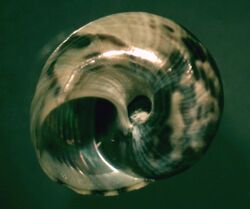Biology:Cantharidus roseus
| Cantharidus roseus | |
|---|---|

| |
| Shell of Cantharidus roseus | |
| Scientific classification Error creating thumbnail: Unable to save thumbnail to destination
| |
| Domain: | Eukaryota |
| Kingdom: | Animalia |
| Phylum: | Mollusca |
| Class: | Gastropoda |
| Subclass: | Vetigastropoda |
| Order: | Trochida |
| Superfamily: | Trochoidea |
| Family: | Trochidae |
| Genus: | Cantharidus |
| Species: | C. roseus
|
| Binomial name | |
| Cantharidus roseus (Hutton, 1873)
| |
| Synonyms | |
| |
Cantharidus roseus is a species of sea snail, a marine gastropod mollusk in the family Trochidae, the top snails.[1]
Description
The length of the shell varies between 4 mm and 12 mm. It grazes on kelp. The small, imperforate, thin, fragile shell has a globosely conoidal shape. Its sculpture consists of very finely spirally striated, with 30 striations on the penultimate whorl and obscured on the body whorl by growth lines. The colour is variable and typical. The 2 apical whorls are white or pinkish-white, on the third whorl 2 purplish bands equidistant from the sutures arise. The 4th whorl is wholly purplish-black, as is the body whorl. In some shells these bands persist on to the last 2 whorls. Additional bands arise so that on the body whorl 5 distinct bands can be counted. Rarely additional minute bands can be seen between these principal bands. In some cases the purple on the last whorl breaks up into irregular dashes. The shells found at ShagPoint are mostly light-coloured. Some have almost a white ground colour, with 5 separate distant bands. Others have a pinkish ground colour, with darker markings between the principal bands. Whilst in some the bands on the body whorl are broken up into dots.
The spire is very short. and contains five whorls. The body whorl is very large, rapidly descending. The suture is distinctly marked. The aperture is large and round. The outer lip is thin, edged with a thin band of white, inside iridescent. The columella is subvertical, semicurved[check spelling], expanding as a callus over the umbilicus.[2]
Distribution
This marine species is endemic to New Zealand and occurs off South Island, Otago to Stewart Island, and Snares Islands.
References
- ↑ Rosenberg, G. (2012). Cantharidus rosea (Hutton, 1873). Accessed through: World Register of Marine Species at http://www.marinespecies.org/aphia.php?p=taxdetails&id=598223 on 2012-11-23
- ↑ Suter H. (1913-1915), Manual of New Zealand Mollusca; Wellington, N. Z. :J. Mackay, govt. printer,1913-1915 (described as Photinula decepta)
- Powell, A.W.B. 1979: New Zealand Mollusca: Marine, Land and Freshwater Shells. Collins, Auckland 500p
- Spencer, H.G.; Marshall, B.A.; Maxwell, P.A.; Grant-Mackie, J.A.; Stilwell, J.D.; Willan, R.C.; Campbell, H.J.; Crampton, J.S.; Henderson, R.A.; Bradshaw, M.A.; Waterhouse, J.B.; Pojeta, J. Jr (2009). Phylum Mollusca: chitons, clams, tusk shells, snails, squids, and kin, in: Gordon, D.P. (Ed.) (2009). New Zealand inventory of biodiversity: 1. Kingdom Animalia: Radiata, Lophotrochozoa, Deuterostomia. pp. 161–254
External links
Wikidata ☰ Q5033770 entry

